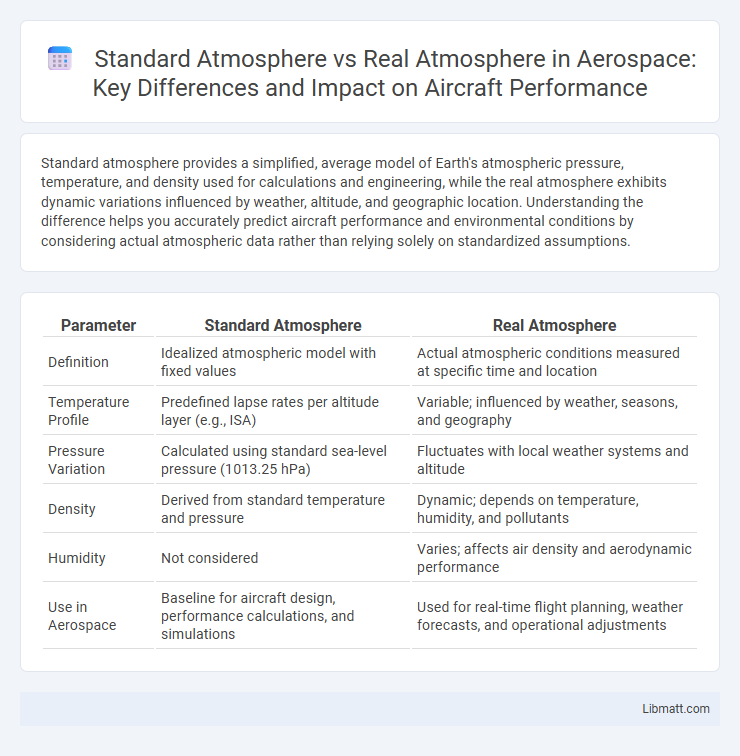Standard atmosphere provides a simplified, average model of Earth's atmospheric pressure, temperature, and density used for calculations and engineering, while the real atmosphere exhibits dynamic variations influenced by weather, altitude, and geographic location. Understanding the difference helps you accurately predict aircraft performance and environmental conditions by considering actual atmospheric data rather than relying solely on standardized assumptions.
Table of Comparison
| Parameter | Standard Atmosphere | Real Atmosphere |
|---|---|---|
| Definition | Idealized atmospheric model with fixed values | Actual atmospheric conditions measured at specific time and location |
| Temperature Profile | Predefined lapse rates per altitude layer (e.g., ISA) | Variable; influenced by weather, seasons, and geography |
| Pressure Variation | Calculated using standard sea-level pressure (1013.25 hPa) | Fluctuates with local weather systems and altitude |
| Density | Derived from standard temperature and pressure | Dynamic; depends on temperature, humidity, and pollutants |
| Humidity | Not considered | Varies; affects air density and aerodynamic performance |
| Use in Aerospace | Baseline for aircraft design, performance calculations, and simulations | Used for real-time flight planning, weather forecasts, and operational adjustments |
Introduction to Standard and Real Atmosphere
Standard atmosphere serves as a reference model representing average atmospheric conditions, including temperature, pressure, and density at various altitudes, while the real atmosphere exhibits dynamic variations due to weather, geographical location, and seasonal changes. This model enables engineers and scientists to predict aircraft performance, design spacecraft, and conduct atmospheric research under consistent conditions. Understanding the differences between standard and real atmosphere helps you adjust calculations and expectations for accurate environmental assessments.
Definition and Purpose of Standard Atmosphere
The standard atmosphere is a mathematical model providing average atmospheric conditions such as temperature, pressure, and density at various altitudes, used for engineering and aviation calculations. It establishes a consistent baseline for comparing real atmospheric data, ensuring uniformity in the design and testing of aircraft, spacecraft, and meteorological instruments. Unlike the variable real atmosphere, which fluctuates due to weather, geography, and time, the standard atmosphere simplifies analysis by representing an idealized, stable environment.
Characteristics of Real (Actual) Atmosphere
The real atmosphere exhibits variability in temperature, pressure, humidity, and wind patterns due to geographic location, altitude, and weather systems, contrasting with the standardized and idealized conditions assumed in the standard atmosphere model. Unlike the uniform lapse rate and constant composition in the standard atmosphere, real atmospheric conditions include turbulence, temperature inversions, and localized phenomena such as storms and jet streams. This variability affects aviation, meteorology, and environmental studies by influencing aircraft performance, weather forecasting, and pollutant dispersion models.
Key Differences Between Standard and Real Atmosphere
Standard atmosphere provides a fixed model representing average atmospheric conditions based on altitude, including temperature, pressure, and density profiles, used for engineering and aviation calculations. Real atmosphere exhibits significant variability influenced by geographic location, weather patterns, humidity, and seasonal changes, which cause deviations from the standard values. These differences impact aerodynamics, flight performance, and environmental studies, necessitating real-time atmospheric data for precise applications.
Temperature Profiles: Standard vs Real Atmosphere
The standard atmosphere assumes a fixed temperature lapse rate decreasing at 6.5degC per kilometer up to the tropopause, providing a uniform reference for altitude-related temperature calculations. In contrast, real atmospheric temperature profiles vary significantly due to weather patterns, seasonal changes, and geographic location, often showing temperature inversions and irregular gradients. Accurate atmospheric modeling for aviation and meteorology requires accounting for these deviations from the standard atmosphere to ensure precise altitude and density estimations.
Pressure and Density Variations in Both Atmospheres
The standard atmosphere assumes a fixed pressure of 1013.25 hPa at sea level and decreases predictably with altitude, while real atmospheric pressure varies due to weather systems and geographic factors. Density in the standard atmosphere follows an idealized gradient based on temperature and pressure, but actual air density fluctuates with humidity, temperature anomalies, and local atmospheric conditions. These variations in pressure and density affect aviation performance calculations, weather prediction models, and environmental assessments where precise atmospheric data is critical.
Effects of Humidity and Moisture
Humidity and moisture significantly affect the density and composition of real atmosphere compared to the standard atmosphere model, which assumes dry air conditions. Increased water vapor content lowers air density and alters temperature and pressure profiles, impacting aerodynamic calculations and weather predictions. Understanding these variations helps you adjust models for more accurate assessments in meteorology and aviation.
Applications in Aviation and Engineering
Standard atmosphere provides a baseline model of atmospheric conditions, such as temperature, pressure, and density, essential for calibrating aircraft instruments and designing aerospace components. Real atmosphere varies due to weather patterns and altitude, requiring pilots and engineers to adjust performance calculations for safety and efficiency. Understanding these differences helps your flight planning and structural design accurately reflect operational environments.
Limitations of Standard Atmosphere Models
Standard atmosphere models provide simplified data on temperature, pressure, and density at various altitudes, but they do not account for local weather variations, temperature inversions, or humidity changes. These models assume average conditions, leading to discrepancies when applied to specific geographic locations or dynamic atmospheric phenomena. The lack of real-time adaptability limits their accuracy in precise aviation, meteorology, and environmental assessments.
Importance of Real-Time Atmospheric Data
Standard atmosphere models provide baseline conditions for temperature, pressure, and humidity, but real atmosphere varies significantly due to geographical and temporal factors. Real-time atmospheric data is crucial for accurate weather forecasting, aviation safety, and environmental monitoring, enabling adaptive responses to changing conditions. Incorporating live data ensures precision in simulations and decision-making processes across meteorology and aerospace industries.
standard atmosphere vs real atmosphere Infographic

 libmatt.com
libmatt.com